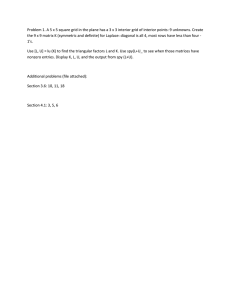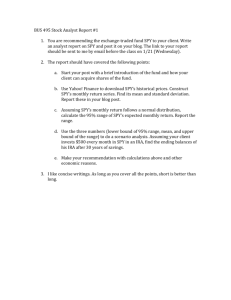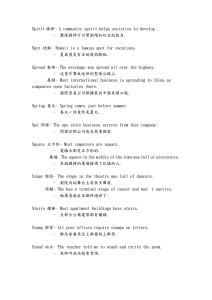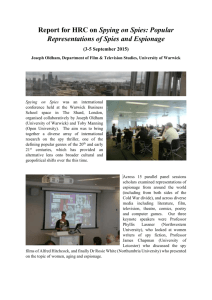Physicist. Defector. Spy?
advertisement
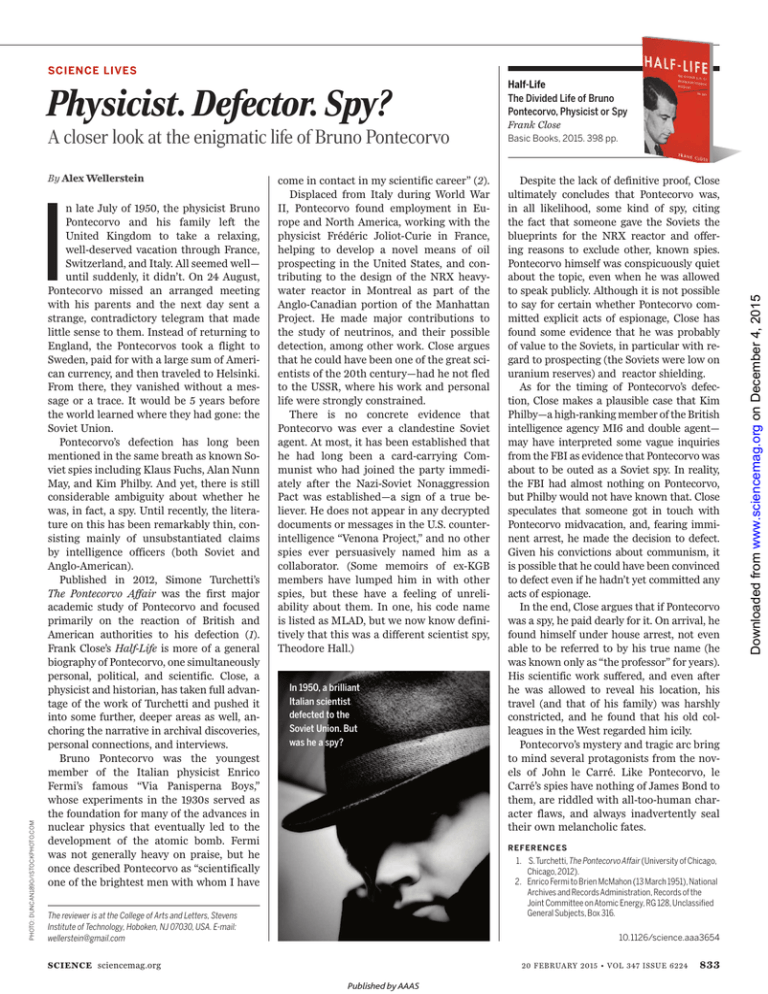
SCIENCE LIVES A closer look at the enigmatic life of Bruno Pontecorvo By Alex Wellerstein PHOTO: DUNCAN1890/ISTOCKPHOTO.COM I n late July of 1950, the physicist Bruno Pontecorvo and his family left the United Kingdom to take a relaxing, well-deserved vacation through France, Switzerland, and Italy. All seemed well— until suddenly, it didn’t. On 24 August, Pontecorvo missed an arranged meeting with his parents and the next day sent a strange, contradictory telegram that made little sense to them. Instead of returning to England, the Pontecorvos took a flight to Sweden, paid for with a large sum of American currency, and then traveled to Helsinki. From there, they vanished without a message or a trace. It would be 5 years before the world learned where they had gone: the Soviet Union. Pontecorvo’s defection has long been mentioned in the same breath as known Soviet spies including Klaus Fuchs, Alan Nunn May, and Kim Philby. And yet, there is still considerable ambiguity about whether he was, in fact, a spy. Until recently, the literature on this has been remarkably thin, consisting mainly of unsubstantiated claims by intelligence officers (both Soviet and Anglo-American). Published in 2012, Simone Turchetti’s The Pontecorvo Affair was the first major academic study of Pontecorvo and focused primarily on the reaction of British and American authorities to his defection (1). Frank Close’s Half-Life is more of a general biography of Pontecorvo, one simultaneously personal, political, and scientific. Close, a physicist and historian, has taken full advantage of the work of Turchetti and pushed it into some further, deeper areas as well, anchoring the narrative in archival discoveries, personal connections, and interviews. Bruno Pontecorvo was the youngest member of the Italian physicist Enrico Fermi’s famous “Via Panisperna Boys,” whose experiments in the 1930s served as the foundation for many of the advances in nuclear physics that eventually led to the development of the atomic bomb. Fermi was not generally heavy on praise, but he once described Pontecorvo as “scientifically one of the brightest men with whom I have come in contact in my scientific career” (2). Displaced from Italy during World War II, Pontecorvo found employment in Europe and North America, working with the physicist Frédéric Joliot-Curie in France, helping to develop a novel means of oil prospecting in the United States, and contributing to the design of the NRX heavywater reactor in Montreal as part of the Anglo-Canadian portion of the Manhattan Project. He made major contributions to the study of neutrinos, and their possible detection, among other work. Close argues that he could have been one of the great scientists of the 20th century—had he not fled to the USSR, where his work and personal life were strongly constrained. There is no concrete evidence that Pontecorvo was ever a clandestine Soviet agent. At most, it has been established that he had long been a card-carrying Communist who had joined the party immediately after the Nazi-Soviet Nonaggression Pact was established—a sign of a true believer. He does not appear in any decrypted documents or messages in the U.S. counterintelligence “Venona Project,” and no other spies ever persuasively named him as a collaborator. (Some memoirs of ex-KGB members have lumped him in with other spies, but these have a feeling of unreliability about them. In one, his code name is listed as MLAD, but we now know definitively that this was a different scientist spy, Theodore Hall.) In 1950, a brilliant Italian scientist defected to the Soviet Union. But was he a spy? Basic Books, 2015. 398 pp. Despite the lack of definitive proof, Close ultimately concludes that Pontecorvo was, in all likelihood, some kind of spy, citing the fact that someone gave the Soviets the blueprints for the NRX reactor and offering reasons to exclude other, known spies. Pontecorvo himself was conspicuously quiet about the topic, even when he was allowed to speak publicly. Although it is not possible to say for certain whether Pontecorvo committed explicit acts of espionage, Close has found some evidence that he was probably of value to the Soviets, in particular with regard to prospecting (the Soviets were low on uranium reserves) and reactor shielding. As for the timing of Pontecorvo’s defection, Close makes a plausible case that Kim Philby—a high-ranking member of the British intelligence agency MI6 and double agent— may have interpreted some vague inquiries from the FBI as evidence that Pontecorvo was about to be outed as a Soviet spy. In reality, the FBI had almost nothing on Pontecorvo, but Philby would not have known that. Close speculates that someone got in touch with Pontecorvo midvacation, and, fearing imminent arrest, he made the decision to defect. Given his convictions about communism, it is possible that he could have been convinced to defect even if he hadn’t yet committed any acts of espionage. In the end, Close argues that if Pontecorvo was a spy, he paid dearly for it. On arrival, he found himself under house arrest, not even able to be referred to by his true name (he was known only as “the professor” for years). His scientific work suffered, and even after he was allowed to reveal his location, his travel (and that of his family) was harshly constricted, and he found that his old colleagues in the West regarded him icily. Pontecorvo’s mystery and tragic arc bring to mind several protagonists from the novels of John le Carré. Like Pontecorvo, le Carré’s spies have nothing of James Bond to them, are riddled with all-too-human character flaws, and always inadvertently seal their own melancholic fates. REFERENCES 1. S. Turchetti, The Pontecorvo Affair (University of Chicago, Chicago, 2012). 2. Enrico Fermi to Brien McMahon (13 March 1951), National Archives and Records Administration, Records of the Joint Committee on Atomic Energy, RG 128, Unclassified General Subjects, Box 316. The reviewer is at the College of Arts and Letters, Stevens Institute of Technology, Hoboken, NJ 07030, USA. E-mail: wellerstein@gmail.com 10.1126/science.aaa3654 SCIENCE sciencemag.org 20 FEBRUARY 2015 • VOL 347 ISSUE 6224 Published by AAAS 833 Downloaded from www.sciencemag.org on December 4, 2015 Physicist. Defector. Spy? Half-Life The Divided Life of Bruno Pontecorvo, Physicist or Spy Frank Close

